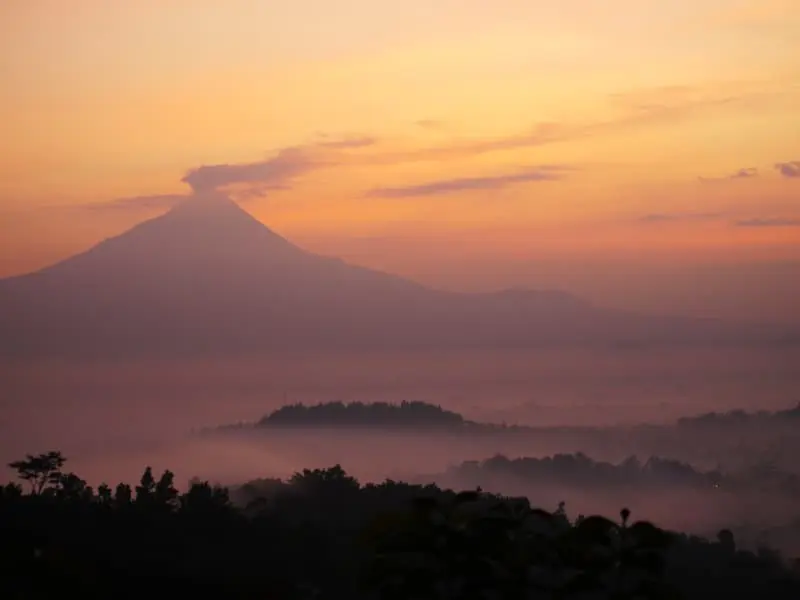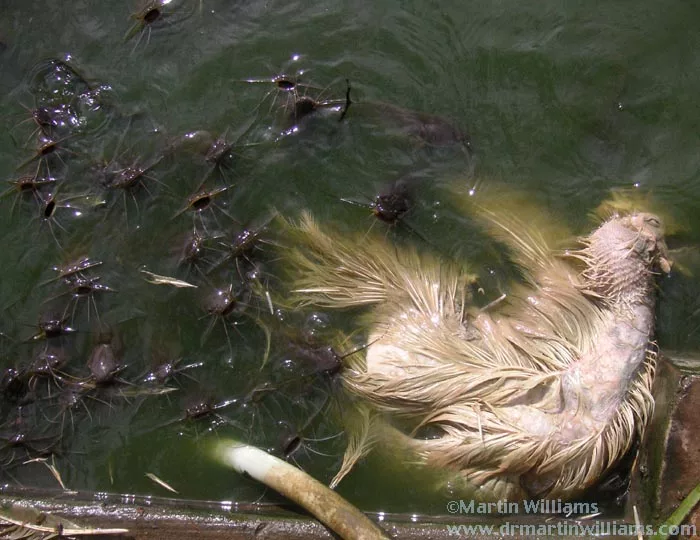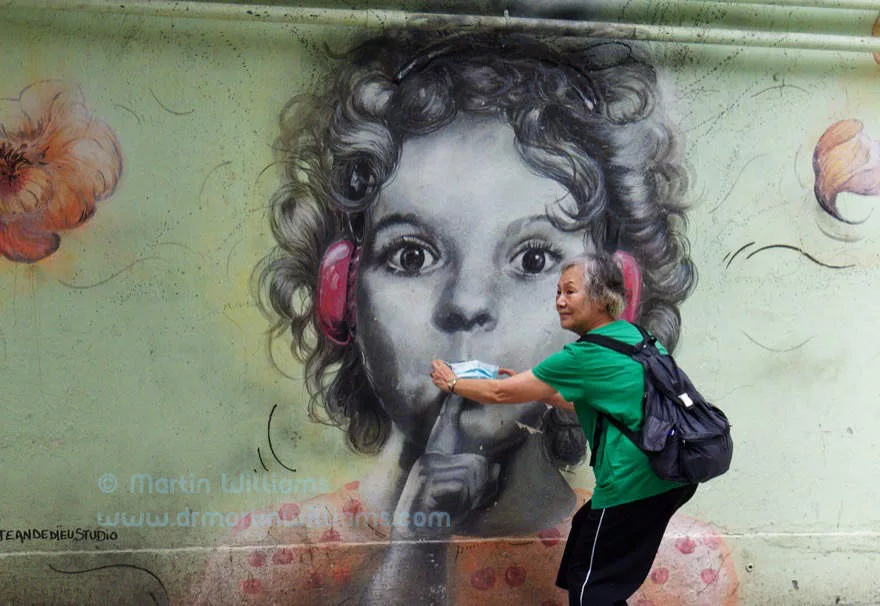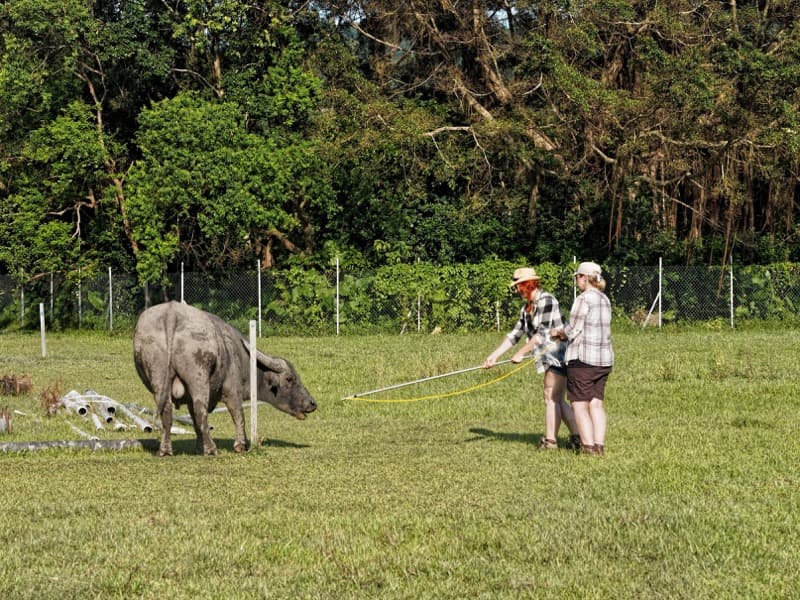Roaming across a satellite crater of Tengkabahan Perahu – the “Upside Down Boat” volcano in west Java, Indonesia – gives some inkling of the awesome power in the Earth beneath. It’s a primeval place, an expanse of yellowish and sullen red rock forming a gently sloping depression amidst jungle. Steam rises from a perpetually boiling spring, hot sulphurous gases emerge from vents.

The larger, main crater is above. Here, a column of steamy gases surges skywards, thrust from an opening at such pressure that, even from some two hundred metres above, it sounds like a powerful waterfall. A road leads to the rim, where a path passes simple cafes and souvenir stalls. Hundreds of visitors arrive during the morning, as if this is as safe as a regular tourist spot.
Yet the volcano is dangerous, subject to phreatic eruptions in which water superheats to become steam that blasts rock apart. Just weeks after my visit, a phreatic eruption creates a plume of ash that covers the car park, and closes the volcano to visitors. In May this year, a more violent phreatic eruption killed five climbers on the Mayon volcano, in the Philippines.
Phreatic eruptions can be hard to predict, but increased ash coupled to seismic activity prior to the latest one at Tangkuban Perahu did lead to a higher alert level. Monitoring equipment here also checks gas compositions, as scientists have found these can change prior to an eruption. Other warning signs can include the ground being pushed upwards by magma rising from beneath.
This month, there was a report that the Redoubt volcano in Alaska, USA, emitted a “seismic scream” just before an eruption, as a flurry of tiny earthquakes built to a crescendo of around 30 per second. These “screams” – perhaps audible to people as humming sounds – could be another signal to check for. But, with just 30 seconds of silence between scream and eruption, they may only provide insight about what’s happening deep below ground, rather than enable warnings.
Gunung Merapi – Fire Mountain

In late October 2010, the Indonesian government issued its highest alert level for another Javan volcano, Gunung Merapi — Fire Mountain. There were frequent earthquakes, a lava flow was seen, and evacuation orders were issued for around 19,000 people living on Merapi’s fertile slopes.
Mbah Maridjan, the volcano’s spiritual guardian, was among the few who refused to leave. He died on 26 October, early in a series of eruptions that lasted till the end of November. These resulted in lava flows, pyroclastic flows – clouds of incandescent ash and rocks racing down the slopes, ash columns rising to around 6km, and even a fire ball that soared 2km into the sky. Despite the evacuation order, over 350 people were killed.
I visited Merapi in February this year, and took a jeep ride across a landscape produced by those eruptions. There were ruins of farmhouses, and nearby the driver told us, “For six months, it was too hot to walk on the ground here.” Few plants grew on the rubble.
Bamboo stalls had been erected, as simple stores and cafes for visitors. At one, a lady showed a photo of her former home – a bucolic looking farmhouse amidst lush greenery. “Now, my home is seven metres under this place,” she said.

Torrential rain began falling, and became persistent, turning streams into brown torrents and creating another danger on volcanoes: lahar, mud flows resulting from fresh ash being easily eroded. As the jeep crossed a narrow bridge, the raging stream ripped a spur of land away. Later, a news report told of a man who had been collecting ash in a streambed not getting out to safety in time. He was swept to his death in waters so powerful they also carried his truck downstream.
Indonesia has at least 76 active volcanoes, which is more than any other country. This results from it spanning junctions between four tectonic plates – immense sheets of the Earth’s crust. One of these, the Indo-Australian Plate, dives beneath the Eurasian Plate. As the rock is pushed deeper, it melts to become magma, which rises through fissures to form volcanoes running east from Sumatra, through Java to Bali and beyond.
Supervolcanoes
The area that’s now Hong Kong lay along a plate boundary during the late Jurassic and early Cretaceous, leading to several episodes of volcanic activity.
These culminated in the collapse of the High Island Supervolcano, releasing 1,300 cubic kilometers of ash –roughly 130 times the volume of material erupted by the Philippines’ Mount Pinatubo in 1991. Much of the hot ash welded together to form tuff, with impressive columnar joints you can see today at places like the southeast Sai Kung Peninsula, and islands including the Ninepins.
“Supervolcano” isn’t a rigorous geological term, but is applied to volcanoes capable of massive eruptions. About 50 supereruptions have been identified, with High Island among 11 that ejected over 1000 cubic kilometres of material. More recently examples include Mount Toba in Indonesia, which erupted around 70,000 years ago, leaving a layer of ash across South Asia. There’s a theory that this led to the deaths of so many people that it caused a bottleneck in human evolution, though several researchers dispute this.
Yellowstone in the USA is surely the world’s best-known supervolcano, thanks partly to science fiction tales envisaging a devastating modern eruption, and media articles such as a CNN article describing it as a “geological time bomb” and suggesting that “After the initial eruption, clouds of gas and rock would burn everything in its [sic] path,” and, “Ashfall would cover the western United States and also enter the jet stream with the potential to cripple air transportation and threaten the world’s food supply”.
But don’t get too alarmed: as 2012 approached – and you may remember there were notions this was the last year of the Mayan calendar, so a cataclysm would impact Earth – NASA pointed out that super volcanoes only erupt around 1.4 times every million years.
The Secret of Screaming Volcanoes Explained
Supervolcanoes not a threat for 2012
Early warnings of climate change
While climate change resulting from human activities might seem a new-fangled concept, there have been on-point predictions dating back many years.…
Ignoring Science Makes Global Climate Disaster as Inevitable as Titanic Submarine Implosion
Climate change has been prominent in worldwide news this summer (2023), notably as we have just lived through the hottest week…
Have you been bullied into health? Fear, quackery and Covid
So here we are with our modern-day wonder, the internet – where even with a smartphone, you can search for and…
Never mind the antimask-o-sphere. Science shows face masks help reduce Covid spread
Just had one of those silly Twitter “conversations” with someone who had position so fixed, impossible to change with facts. Yeah,…
A Covid scrapbook: snapshots from the crazy pandemic
I’ve read accounts of the Spanish Flu, which was the last major pandemic, mainly in 1918 [so over and done with…
Highly pathogenic bird flu variants mostly evolve in intensive poultry farming
Highly pathogenic bird flu variants evolve from regular, low pathogenic, bird flus, within intensive poultry farming.
Keep Your Underpants Duck Taped and Air Clean as Covid Wild Ride Continues
We’ve learned a lot about Covid, even developing vaccines. Yet Covid remains an issue, no matter how much we might wish…
Covid is airborne so ventilation and air filtration are important
Since early in the pandemic, I’ve been seeing scientists arguing Covid is airborne, even with hashtag #covidisairborne – including to counter…
Long Covid – info and links indicating major impact
Evidence is snowballing that Long Covid is also a serious issue, even affecting people in whom the disease initially appeared mild.
Perhaps Covid arose through lab leak of tweaked bat Coronavirus
Maybe humans tweaked bat coronaviruses in gain of function experiments, inadvertently creating Covid thro lab leak.
The Covid Conundrum: Endless Lockdowns, Let It Rip … or What?
Covid is airborne, which means that much as unprotected sex is a risk for HIV, unprotected breathing might result in Covid.
Science shows Covid including Omicron is Really Not the Flu
Some of the science showing Covid including Omicron is a huge issue; and one that looks set to be with us…
“Alarmist” Covid predictions outperform Covid deniers’ soothsaying
The disinfo downplaying Covid is often from rightwing, mainly money-minded folks who perhaps don’t care too much about actual people.
Covid virulence, vaccines and variants
Science can provide some insights into what may happen with Covid, along with ways to limit its impacts.
We’re in the Covid Era for the Long Haul
We’re in this for the long haul, with the virus like a relentless, invisible foe, ready to exploit errors, slip through…
My Strange n Surprising Summer Staycation with Cellulitis
rom quick pricking by unseen marine creature, to intense fever, and hospital stay for an infection deep within the skin.
Covid virulence, vaccines and variants
[Written for South China Morning Post on 6 January 2021] In January last year, as reports were emerging of the new…
The Viral Time Bomb – Pandemic of Our Time
Guan Yi, director of the State Key Laboratory of Emerging Infectious Diseases at Hong Kong University, has extensive experience of viruses;…
From China With Fear: the Wuhan Coronavirus Won’t Kill Us All
As news of Wuhan coronavirus emerges, evolutionary biology suggests potential for a pandemic, not killing high percentage of people.
Fightback Needed as Science and Life Support System Under Attack
Environmentalism is under assault; yet this planet is the only home we have; providing our food, air, water… It’s our life…
Secret World of Hong Kong Water Supply
Hong Kong’s water supply system has been vital to its development as a “world city”.
Hong Kong Belching Buffaloes n Bubbling Paddies and the Mystery Methane Rise
Prof Euan Nisbet leads a science team to Hong Kong in quest to help find why levels of potent greenhouse gas…




















